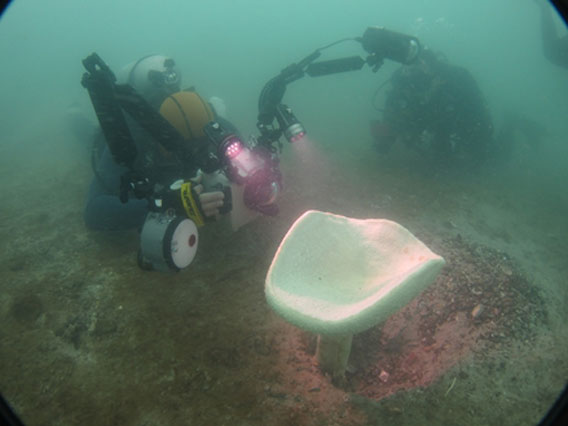
Neptune’s cup used as a bathtub for a child before overharvesting almost pushed the species to extinction.
Not found alive for over a century the evocatively named Neptune’s cup sponge (Cliona patera) has been rediscovered off the shores of Singapore. Researchers with the environmental consulting DHI Group found the species during a routine dive. Although the specimen they found was small, the goblet-shaped sponge can reach nearly 5 feet (1.5 meters) high and the same in diameter.
“When we came across the sponge, we knew immediately that this was something very different,” marine biologist Karenne Tun from DHI said in a press release.
First described in 1822, full-grown Neptune cups were used as bathtubs for children. Overharvesting for the magnificent organism, however, led to its near extinction. The sponge was last sighted in 1908 in Indonesian waters and believed to be extinct since then. However, dead Neptune’s cups were found in dredge samples from northern Australia in the 1990s, providing hope that the species was still around.
“Basically, little is known about the Neptune’s Cup, as it was never found alive,” adds Tun. “Now we have the opportunity to study the biology and ecology of this impressive sponge and learn about its life cycle. […] We’ve already had the first surprise: The Neptune’s cup was thought to be a very slow growing species. However, between our last visits in April and August, respectively, it had grown several centimeters.”
Evolving over 150 million years ago, sponges anchor themselves to the marine floor, feeding on plankton and other small marine animals as water passes through their filtering bodies.

DHI and the National University of Singapore biologist taking a closer look at one of the young Neptune’s Cup sponges. Photo courtesy of DHI Group.
Related articles
Extinct frog rediscovered in Israel
(11/21/2011) After its marshland was drained, researchers thought the Hula painted frog (Discoglossus nigriventer) had vanished for good. However a patrol at the Ha-Hula lake in Israel recently discovered a single female amphibian that turned out to be the long-lost, and long-sought, Hula painted frog.
Over 80 percent of rediscovered species still face extinction

(08/18/2011) Imagine if your job was to locate extinct species. In 2010, biologists with The Search for Lost Frogs set out on a tropical mission hoping to confirm the existence of frog species not seen in decades. The team recovered proof of four out of a hundred missing species, including a toad among the expedition’s Top Ten Amphibians list. According to a new study study in the open access journal PLoS ONE, such biological surveys are critical conservation tools to prevent the ‘romeo error’: the abandonment of conservation efforts due to belief that a species is extinct. The study, the first of its kind, found that rediscovered species are especially in danger of vanishing again, this time altogether, without targeted conservation measures.
First ever picture of long lost rainbow toad

(07/13/2011) Scientists are elated after the surprise rediscovery of a wildly-colored frog not seen for 87 years and never before photographed—until now. The Bornean rainbow toad, also known as the Sambas Stream toad (Ansonia latidisca) was rediscovered on Borneo in the Malaysian state of Sarawak by local scientists inspired by a 2010 search for the world’s missing amphibians by Conservation International (CI). Leading up to its search CI released the World’s Top 10 Most Wanted Lost Frogs (out of a hundred being searched for): the Bornean rainbow toad was listed as number 10.














